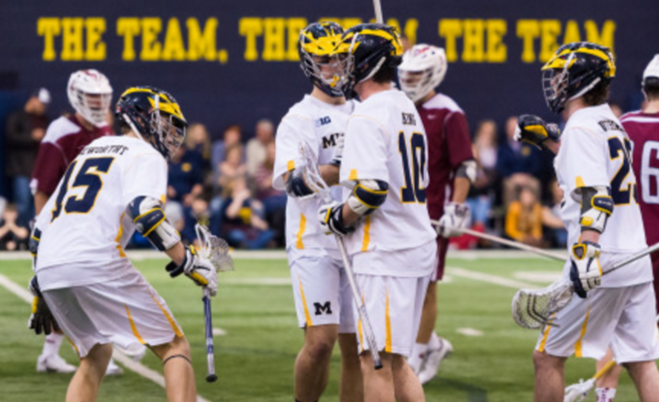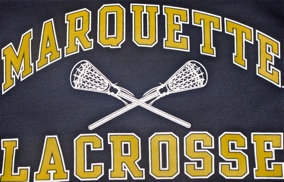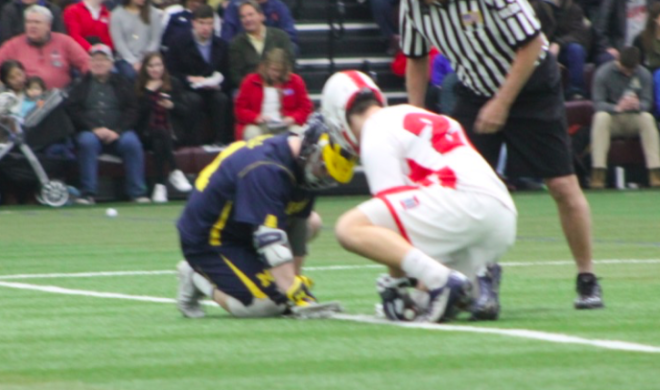U-M flopped in its first opportunity to dispatch a bigtime opponent this year (16-5 at Notre Dame). While Penn isn’t on the same level, the Quakers are a ranked team nonetheless – and they visit the Big House today.
Penn
March 11, 2017, 1 p.m. EST
Michigan Stadium
Live stats. Video.
Michigan preview. Penn preview.
@UMichLacrosse. @UofMLaxManagers.
@pennmenslax.
The Quakers
Penn is 3-1 this year, with the lone loss by a single goal on the road against Penn State (a team ranked No. 3, despite consensus – including among those who do the rankings – that they are overrated). That strong start, along with the pre-season expectations, sees the Quakers come in a consensus No. 10 in the national rankings.
Wins over UVa and Navy (the former still ranked, latter receiving votes prior to the mid-week Penn victory) are pretty solid, and a blowout over fellow Philly squad St. Joseph’s gives the Ivy squad a much better early-season resume than Michigan, whose victims to date have just a handful of wins between them.
Offense
Sophomore attack Simon Mathias is Penn’s leading scorer so far, putting together a seven-goal, six-assist line so far for a very balanced output. He’s a bigger attackman, standing 6-2, 190 – not a mini dodger-feeder. The more classically sized attackman is fellow sophomore Tyler Dunn, a 5-11, 190-pounder whose statline reads more like a midfielder, with ten goals and just one assist. He’s your crease finisher. The third starter is another sophomore, Alex Roesner, who, like Dunn, is primarily a finisher with eight goals and nary an assist.
The Quakers have shuffled through starting lineups (and are listed with a very confusing five attackmen and one midfielder for the St. Joe’s game), with freshman Keyveat Postell also earning a couple starts in there. The No. 4 attackman certainly doesn’t add any experience to what is a pretty young front line. Postell has started at midfield in the games he was not in the starting attack, but his relatively pedestrian scoreline (two goals, one assist) indicates he’s not as big a threat as other players. He and Roesner rotate between which is on attack and which is playing midfield.
The other starting midfielders are junior Kevin McGeary, a bit of a feeder (on what is not a particularly assist-dependent offense) with two goals and four assists, and big junior Reilly Hupfeldt – six goals and two assists, and a pure midfielder though he’s listed as an attackman on the roster – who runs 6-2, 215. Joe Licciardi will also mix in, though he hasn’t been particularly productive yet.
The defensive corps will get in on the scoring, however, with LSM Connor Keating already potting four goals, at least one in each game except against PSU (he scored twice Wednesday against Navy). That’s something to watch, especially if Michigan manages to have its clear broken.
The advanced stats like this offense quite a bit, putting it among the nation’s top 15 or so, and the versatility in personnel really helps there.
Defense
Keating is also the team’s ground ball leader – as LSMs often are, especially those who play on the wing for faceoffs – but is not much of a threat to simply take the ball away.
That responsibility falls to the close defense, especially its unquestioned leader Kevin Gayhardt. The 6-6, 225-pound senior is tied with Keating for the team’s ground ball lead with 13, and has seven caused turnovers in just four games (albeit concentrated with three against Navy and four against Virginia). Fellow senior Eric Persky doesn’t have the size at 5-11, 200, but has started every game alongside Gayhardt. He has only three ground balls on the year, though. Kevin McDonough and Mike Mulqueen have split the starts at the third close defense position, with neither accomplishing much of anything – and each only boasting two ground balls on the year.
Reed Junkin has been the Quakers’ goalie for every second of gameplay in 2017. He has relatively pedestrian stats – a .542 save percentage and 9.50 goals against average despite playing for one of the slowest teams in the country – and adding that all up… sort of makes it confusing why the defensive efficiency looks pretty good (until you see what the pace means in a moment…)
Special teams
The Quakers are one of the slowest teams in the country (according to AnalyticsLacrosse, run by IL‘s Patrick McEwen), which, combined with their possession percentage, has to mean they have by far the fewest offensive possessions of any team in the country. Thanks to a pathetic .316 mark on faceoffs, and a clear that is only OK combined with a lack of desire to ride, they have just 46.7% of possessions on the year, or 115 opportunities in four games, fewer than 29 per contest.
That faceoff issue has been spread a bit across the roster – four different guys have taken at least two draws – with the top two options both performing very poorly. Chris Santangelo is the No. 1 guy, and his ability to turn faceoff wins into offense (two goals and two assists) is better than his ability to turn attempts into wins in the first place (.347 wins). Backup Jack Ulrich is barely clearing 20%.
The Quakers have a .887 clearing mark, which is fine, but they haven’t faced heavy-riding teams yet this year. They are also very much not a heavy-riding team themselves, forcing only five fails in four games so far.
The Quakers have played in relatively clean games so far this year (Michigan will be the most penalty-prone team they’ve played), with both their own EMO and opponents’ having trouble converting.
Overall
The record and the opponents defeated make Penn look pretty good, for the most part. Looking at the stats, though, it’s an absolute mystery how they’ve done it: they have a moderately-efficient offense and defense (in raw terms; the opponent-adjusted numbers are a bit better), and are terrible in the possession game. Obviously they’ve done it against a good slate, but this does look like a squad that’s poised to struggle in a game where they simply can’t get ahold of the ball.
Michigan is a good faceoff team, so can the Wolverines be the squad that upsets the rickety apple cart here? It’s possible, and would be a huge win for the program. The highest-ranked team to fall victim to U-M in the six years of existence would probably vault U-M comfortably into the rankings should they pull the upset. Even coming close against the Quakers would give the Maize and Blue a chance to be on the fringe of the rankings come Big Ten play.
Predictions
Penn is obviously a bit better than the raw numbers make them look, but this early in the year (especially for Ivy League teams, which start late and therefore have played fewer games than other notable ones), there’s a bit of noise in the opponent-adjustment of those numbers, too. There’s a vulnerability here.
- Michigan should dominate possession in this game. A good faceoff team against a bad one is an obvious advantage, and Mike McDonnell should be able to exceed .667 at the dot. Michigan’s clear is the x-factor here. While Penn doesn’t ride, U-M has shown an ability to fail clears without much help from the opponent. Have a consistent day clearing, and the path to a huge advantage is obvious.
- Penn’s offense, when they do get the ball into U-M territory, is going to be a problem. Michigan has a solid defense, but has let mediocre-to-poor teams tread water a bit too much lately. Against a potentially elite offense – and one with a lot of versatility in personnel, which Michigan hasn’t had to deal with much this year – there’s a chance it all falls apart. Tommy Heidt can equalize that, and will have to if U-M is to shut down the Quakers.
- I’m not at all impressed with the Penn defense, even if the efficiency numbers are pretty good. UVa and Penn State hit double-digits despite a very slow pace of play out of the Quakers (Penn State is also pretty slow – so naturally those squads played a 64-possession game), and Navy was pretty close. Michigan isn’t in the realm of the Cavs or Nittany Lions, most likely, but not far off Navy. One good game – against a mediocre goalie, no less – could be a difference-maker in perception.
- One of the keys for Michigan, therefore, will be avoiding turnovers. Penn forces TOs on .160 of opponents possessions, with .260 of other possessions resulting in an unforced turnover. Play smart ball, don’t give it away unforced, and this Penn team doesn’t stop you a whole lot. Unfortunately, I’ll believe Michigan can do that when I see it.
- Penalties will also be an interesting data point. Michigan plays a pretty loose style of game, that results in them both going man-down (39 opponent attempts this year, 11 more than No. 2) and man-up (just above middle-of-the-pack nationally) a whole lot. If U-M gives Penn chances with the advantage, the Quakers may snap out of a 3/11 performance this year and hit around 50%. That could be the difference-maker.
It’s very tempting to pick the upset in this one: I don’t think Penn is particularly good, but Michigan isn’t necessarily the team to exploit that. It should be close, probably closer than the experts think (the LaxVegasLine is Penn -4), and the Wolverines will have a shot to steal it. However, they won’t, and Penn takes the 11-9 victory, the Quakers’ second by that scoreline in the past four days








